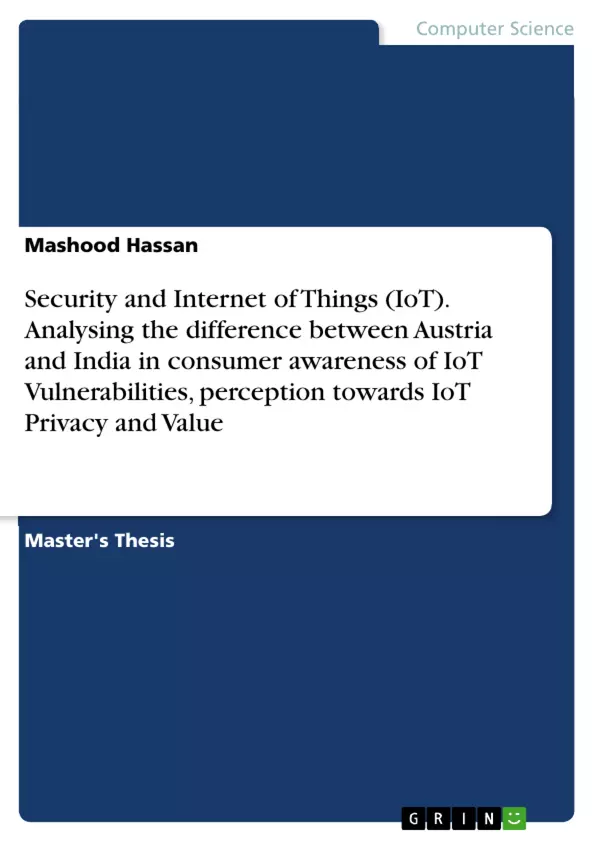The vision of internet of things (IoT) has become a reality and in recent years, it has seen rapid growth. However, there is a lot more to come from this technological Tsunami. In simple terms, Internet of Things is a network of interconnected objects or things with sensors, collecting data and making actionable decisions. With the arrival and adaptation of this technology, many questions regarding cyber security are raised.
This master thesis examines the consumer perspective on key elements of the internet of things. The elements in focus are consumer awareness, the perception of privacy and perception of value. The relationship of these elements with Gender and Nationality is investigated. The study is based on the survey of respondents belonging to Austria and India. After interviewing two experts from the field of the internet of things and reviewing the literature, the vulnerabilities surrounding IoT were confirmed.
Lack of consumer awareness is considered a hindrance in the adaptation of IoT, whereas the trust between technology and consumers has decreased over time. It is claimed that consumers do not value security enough to pay extra for it. However, the findings from this study suggest a shift in the understanding and attitude of the consumer base. The author finds while certain trends from previous researchers remain unchanged. There has been an increased awareness among consumers overall.
Gender influences the awareness; value perception of consumers is also influenced by Gender and Nationality. The perception of privacy is negative and the trust of consumers remains low. Most people would like to see more work done by the industry and the government to increase consumer education regarding cybersecurity and Internet of Things.
Inhaltsverzeichnis (Table of Contents)
- Introduction
- Research Motivation and Purpose
- Previous research done on Internet of Things
- Research Gap (How is this study different?)
- Choice of Countries
- Gender
- Expected Outcome
- What is Internet of Things?
- Economic Impact
- Internet of Things Segments
- Growth
- Security and Internet of Things
- Consumer awareness of IoT Vulnerabilities
- Perception towards Privacy
- Value Perception of Internet of Things
- Research Methodology and Research Method
- The Research Process
- Selected Research Methods and Methodology
- Theoretical Framework
- Research Questions and Variables
- Interview and Survey
- Findings from the Interview
- Survey Questions
- Results
- Analysis
- Discussion
Zielsetzung und Themenschwerpunkte (Objectives and Key Themes)
This master thesis aims to examine consumer perspectives on key elements of the Internet of Things, specifically focusing on consumer awareness, perception of privacy, and perception of value. The study investigates how these elements are influenced by gender and nationality, comparing respondents from Austria and India. The research utilizes a survey approach, supplemented by interviews with experts in the field of IoT.
- Consumer awareness of IoT vulnerabilities
- Perception of privacy in relation to IoT devices
- Value perception of IoT technology
- Impact of gender on consumer attitudes towards IoT
- Comparison of consumer perspectives between Austria and India
Zusammenfassung der Kapitel (Chapter Summaries)
- Introduction: This chapter sets the stage for the research by outlining its motivation, purpose, and methodology. It also discusses previous research on IoT, identifies the study's unique contribution, and explains the choice of countries and the expected outcome.
- What is Internet of Things?: This chapter provides a comprehensive overview of the Internet of Things, encompassing its economic impact, segments, growth, security concerns, and the specific elements of consumer awareness, privacy perception, and value perception that the study focuses on.
- Research Methodology and Research Method: This chapter details the research process employed, the specific methods used (survey and interviews), and the theoretical framework underpinning the study. It also defines the research questions and variables.
- Interview and Survey: This chapter presents the findings from expert interviews and outlines the survey questions used to gather data from respondents in Austria and India.
- Results: This chapter analyzes the survey data, providing insights into consumer attitudes and behaviors related to IoT. The analysis focuses on the key themes of awareness, privacy, value, gender, and nationality.
- Discussion: This chapter interprets the findings from the data analysis and discusses their implications for understanding consumer perspectives on IoT.
Schlüsselwörter (Keywords)
This research revolves around the Internet of Things, its associated security considerations, and consumer perceptions. Key themes include consumer awareness of IoT vulnerabilities, perception of privacy, value perception, and the influence of gender and nationality on these factors. The study compares the perspectives of consumers in Austria and India, providing a valuable understanding of the diverse attitudes and concerns surrounding the adoption and utilization of IoT technology.
- Citation du texte
- Mashood Hassan (Auteur), 2017, Security and Internet of Things (IoT). Analysing the difference between Austria and India in consumer awareness of IoT Vulnerabilities, perception towards IoT Privacy and Value, Munich, GRIN Verlag, https://www.grin.com/document/388671



